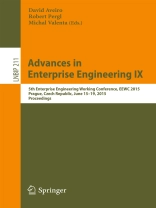This book constitutes the proceedings of the 5th Enterprise Engineering Working Conference, EEWC 2015, held in Prague, Czech Republic, during May 15–19, 2015. EEWC aims at addressing the challenges that modern and complex enterprises face in a rapidly changing world. The participants of the working conference share a belief that dealing with these challenges requires rigorous and scientific solutions, focusing on the design and engineering of enterprises. The goal of EEWC is to stimulate interaction between the different stakeholders, scientists as well as practitioners, interested in making enterprise engineering a reality.The 10 papers included in this book were presented at EEWC after being carefully reviewed and selected out of 29 submissions. The topics of the presented papers allowed for active participation in interesting discussions and exchange of ideas and stimulated future cooperation among the participants. This made EEWC a real ‘working conference’ contributing to the further development of enterprise engineering as a mature discipline. Topics covered include: enterprise engineering and DEMO; business process management, simulation, and analysis; and complexity, transformation, and modeling.
قائمة المحتويات
On Enterprise Engineering and DEMO.- Enterprise Operational Analysis Using DEMO and the Enterprise Operating System.- Engineering the Decision-Making Process Using Multiple Markov Theories and DEMO.- Towards Competence-Based Enterprise Restructuring Using Ontologies.- The Enterprise Engineering Domain.- On Business Process Management, Simulation and Analysis.- Towards Multi-perspective Modeling with BPMN.- Analysis of Business Processes with Enterprise Ontology and Process Mining.- A Case Study of Business Process Simulation in the Context of Enterprise Engineering.- On Complexity, Transformation and Modeling.- On the Role of Complexity for Guiding Enterprise Transformations.- On the Explanatory Capabilities of Enterprise Modeling Approaches.- A Non-arbitrary Method for Estimating IT Business Function Recovery Complexity via Software Complexity.












